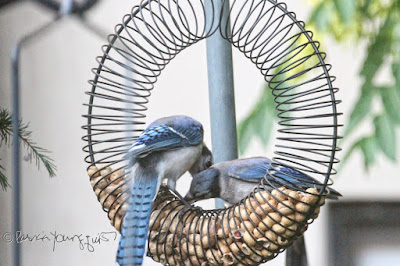The photographs atop this entry features a blue jay alighting on the twisting branches of one of the shrubs growing in my urban garden which is a Avellana corylus (Contorted Hazelnut). In the image he/she is eyeing a ball-style bird feeder that is nearly empty of the black-oil sunflower seeds which it holds. Blue Jays are known to eat these seeds as evidenced in the photo below, where a blue jay is availing him/herself of black-oil sunflowers seeds which I had placed on a a saucer.
This bird-type also enjoys eating berries, especially blueberries, as evidenced by the next set of images.
And blue jays eat suet, as you can see in the photos directly below.
However (according to WBU-MICH), "if you offered a buffet, their first choice would be peanuts in the shell."
I certainly agree with them on this, for I have offered un-shellled peanuts in a variety of ways, and my efforts have not been lost on this bird type!
One of the first un-shelled peanut feeders that I got for my visiting bird was a "canister" style one, which can be seen in the following pictures featuring a blue jay enjoying the accommodations on a sunny winter day.
The latter image has been featured in prior posts here on Blogger. It has also been included in both the digital (iBooks as well as the ePub — Amazon Kindle) versions,
and, the soft-cover version (available exclusively on MagCloud),
of the book, Words In Our Beak Volume One, which as you may know, is written from the perspective of a female cardinal.
In any event, I gave my "canister" style feeder to a convalescing relative, who enjoys watching birds at feeders from her window. I replaced this with a "house style" unshelled peanut feeder which the blue jays also enjoyed, in all seasons, you can see in the next set of images.
But even though the blue jays were able to eat from both the "canister-style" and "house-style feeder" when it snowed, if the snow fall was heavy, and I could not get to the feeders to replenish them, I put unshelled peanuts in a bowl in a place I could get to easily. It seemed the blue jays appreciated my efforts (or at least they still appreciated my un-shelled peanuts), as evidenced in the next set of pictures.
Currently, I have a wreath-style whole peanut feeder in my garden, it can be seen in the images below which feature blue jays taking pleasure in it.
I've published a number of entries re my wreath-style whole peanut bird feeder number of times here on Blogger, where I've included images of other bird types (cardinals, common grackles, and, pigeons) enjoying themselves at this feeder.
So, while Marie Antoinette may have said, "Let them eat cake;" and Tina Fey has recently said, "Let me eat cake;" WBU-MICH and I say, when it comes to blue jays, Let them eat unshelled peanuts.
ADDENDUM FALL 2018:
The digital versions of Volume One within the Words In Our Beak book series that are mentioned in this entry may only remain available for a limited time, but hardcover versions of Volume One, Two and Three can now be found wherever books are sold. Please click here to go to my blog post that provides details as to where you can get these books.
 |
| MY BOOK SERIES |
Additionally, I have rendered some images from these books into other formats and they are available via Fine Art America (FAA). Some of my other photographs (Black & White Collection, Kaleidoscopic Images and the famous Mandarin duck who visited NYC) can also be found on my FAA pages.








































No comments:
Post a Comment
Note: Only a member of this blog may post a comment.